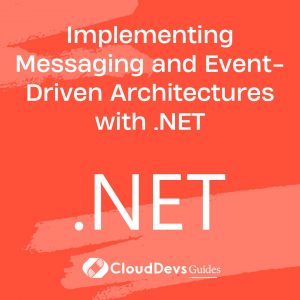Implementing Messaging and Event-Driven Architectures with .NET
Table of Contents
Event-driven architectures (EDA) and messaging systems are crucial for building scalable, responsive, and loosely-coupled systems. These architectures enable applications to react to changes in real time, handle complex workflows, and scale seamlessly. .NET, with its powerful frameworks and libraries, provides an ideal platform for implementing these architectures. This article explores how to leverage .NET for messaging and event-driven systems, complete with practical examples.

Understanding Event-Driven Architecture
Event-Driven Architecture (EDA) is a design pattern where components of a system communicate with each other through events. Events represent significant occurrences within the system, such as user actions, state changes, or external inputs. In EDA, components are loosely coupled, allowing them to be developed, deployed, and scaled independently.
Using .NET for Messaging and Event-Driven Systems
.NET provides robust support for implementing messaging and event-driven systems. With libraries like `MassTransit`, `NServiceBus`, and the `System.Threading.Channels` namespace, developers can build responsive and scalable applications.
Below are key concepts and examples demonstrating how to implement messaging and event-driven architectures with .NET.
1. Setting Up a Message Broker
A message broker is central to any messaging architecture. It routes messages between producers (senders) and consumers (receivers) in an asynchronous manner. Popular brokers include RabbitMQ, Azure Service Bus, and Kafka.
Example: Integrating with RabbitMQ Using MassTransit
MassTransit is a .NET library that simplifies the integration with message brokers like RabbitMQ. Below is a basic example of setting up a message broker using MassTransit.
```csharp
using MassTransit;
using Microsoft.Extensions.DependencyInjection;
using System.Threading.Tasks;
class Program
{
public static async Task Main()
{
var services = new ServiceCollection();
services.AddMassTransit(x =>
{
x.AddConsumer<OrderConsumer>();
x.UsingRabbitMq((context, cfg) =>
{
cfg.Host("rabbitmq://localhost");
cfg.ReceiveEndpoint("order_queue", e =>
{
e.ConfigureConsumer<OrderConsumer>(context);
});
});
});
services.AddMassTransitHostedService();
var provider = services.BuildServiceProvider();
await provider.GetRequiredService<IBusControl>().StartAsync();
}
}
public class OrderConsumer : IConsumer<Order>
{
public Task Consume(ConsumeContext<Order> context)
{
Console.WriteLine($"Order received: {context.Message.Id}");
return Task.CompletedTask;
}
}
public class Order
{
public Guid Id { get; set; }
}
```
2. Implementing Event Sourcing
Event sourcing is an architectural pattern where changes to an application’s state are stored as a sequence of events. This approach provides an audit trail, enables reconstructing past states, and simplifies debugging.
Example: Storing and Replaying Events
Here’s an example of storing events using a simple in-memory event store.
```csharp
using System;
using System.Collections.Generic;
class EventStore
{
private readonly List<IEvent> _events = new List<IEvent>();
public void SaveEvent(IEvent @event)
{
_events.Add(@event);
Console.WriteLine($"Event saved: {@event.GetType().Name}");
}
public IEnumerable<IEvent> GetEvents() => _events;
}
public interface IEvent { }
public class OrderCreated : IEvent
{
public Guid OrderId { get; set; }
}
class Program
{
static void Main()
{
var store = new EventStore();
var orderCreated = new OrderCreated { OrderId = Guid.NewGuid() };
store.SaveEvent(orderCreated);
foreach (var @event in store.GetEvents())
{
Console.WriteLine($"Event replayed: {@event.GetType().Name}");
}
}
}
```
3. Handling Concurrent Events
In event-driven systems, events often occur concurrently. Properly managing concurrency is vital for ensuring data consistency and system reliability.
Example: Using Channels for Concurrency Handling
.NET provides `System.Threading.Channels` for handling concurrency in event-driven applications. Below is an example of using channels to process events concurrently.
```csharp
using System;
using System.Threading.Channels;
using System.Threading.Tasks;
class Program
{
static async Task Main()
{
var channel = Channel.CreateUnbounded<int>();
// Producer
var producer = Task.Run(async () =>
{
for (int i = 0; i < 10; i++)
{
await channel.Writer.WriteAsync(i);
Console.WriteLine($"Produced: {i}");
await Task.Delay(100);
}
channel.Writer.Complete();
});
// Consumer
var consumer = Task.Run(async () =>
{
await foreach (var item in channel.Reader.ReadAllAsync())
{
Console.WriteLine($"Consumed: {item}");
}
});
await Task.WhenAll(producer, consumer);
}
}
```
4. Implementing CQRS (Command Query Responsibility Segregation)
CQRS is a design pattern that separates the read and write operations of a system into different models. This approach enhances scalability and performance, especially in event-driven systems.
Example: Implementing CQRS with MediatR
MediatR is a popular library in .NET for implementing CQRS. Below is a basic example of using MediatR for command handling.
```csharp
using MediatR;
using Microsoft.Extensions.DependencyInjection;
using System;
using System.Threading;
using System.Threading.Tasks;
class Program
{
static async Task Main()
{
var services = new ServiceCollection();
services.AddMediatR(typeof(Program).Assembly);
var provider = services.BuildServiceProvider();
var mediator = provider.GetRequiredService<IMediator>();
await mediator.Send(new CreateOrderCommand { OrderId = Guid.NewGuid() });
}
}
public class CreateOrderCommand : IRequest
{
public Guid OrderId { get; set; }
}
public class CreateOrderHandler : IRequestHandler<CreateOrderCommand>
{
public Task<Unit> Handle(CreateOrderCommand request, CancellationToken cancellationToken)
{
Console.WriteLine($"Order created: {request.OrderId}");
return Task.FromResult(Unit.Value);
}
}
```
Conclusion
Implementing messaging and event-driven architectures with .NET can significantly enhance your application’s scalability, responsiveness, and maintainability. Whether you’re using MassTransit for message brokering, Channels for concurrency handling, or MediatR for CQRS, .NET provides a comprehensive toolset for building robust event-driven systems. Embracing these patterns will enable your applications to handle complex workflows, scale effortlessly, and respond in real-time to events.



